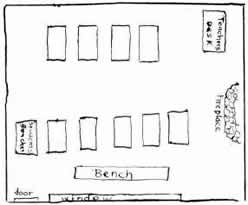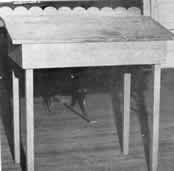 |
Volume I, No. 1, Fall 1973 |
FROM THE WORD GO
by Rita Saeger
I would like to thank Dr. Sam Bradford for contributing so much of his knowledge of his family background and personal experiences which helped make this story possible. Dr. Bradford has done much research on the people of this area of the Ozarks, and his relating of this knowledge is helping to preserve the past.
The people First coming into the Ozarks around 1820 were faced with a transportation problem. Everything they owned they carried by hand or packed on their animals. Consequently, they didn't have room For luxuries such as books, magazines, and newspapers. Without these essentials For education, the only material used as a school text was the Bible. The first schooling took place in the home with the mothers as the first teachers. The more educated mother in a neighborhood of about Four square miles would have neighbor children over to her house where she would teach them.
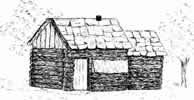
[26]
Following the home teaching were subscription schools which began in the middle 1800's. A subscription school was started by a small number of families that were interested in having an organized classroom atmosphere. These were the first schools in a standard one-room schoolhouse and gave way to the school buildings we know today. Each family would volunteer money, room and board, or transportation for the teacher. One family might give $15, another $30. One family might offer the teacher room and board half the school year, while still another family would offer room and board the remainder of the year. Another family might give the teacher a horse and buggy to use to get to and from school. After they totaled up all these "offerings," they would turn the money over to the school board, who would then employ the teacher. After deciding upon the monthly salary to give a teacher, the school board would then calculate the number of months of school that could be held that year, depending upon the total cash subscription. For example, if the total cash subscription for one year was $60 and they decided to pay the teacher $20 a month, they would then have three months of school. This way, the teacher would know how many months of school she would be expected to teach. The longest term of school they had was usually six months for that was the maximum amount of money that could be collected.
The cost of the building of the subscription school itself was minor, apart from the labor that the people donated. The men would chop the timber, heel the logs, lay them in place, nail on the shingles, build a fireplace, and they had a school building. It didn't take a lot of cash to build the school.
The families encountered many problems during the time of subscription schools, since they were funded entirely by the "subscriptions" of neighborhood families. Very often these families had little or no money to spare to pay the teacher. This would cause a shortened school term of one or two months, or perhaps no school at all for a year. Since school terms were relatively short, there was not much time to teach the material essential for a basic elementary education. Very often children at the age of sixteen or eighteen were still in elementary school.
The one-room school which followed the subscription school was funded in a different manner. At this time much. emphasis was placed on the township which was theoretically a school district. There might be two school districts in a single township or there might be no school district, depending upon population. Land surveyed at this time was all government property and each section (a section is one square mile of land) was numbered. The sixteenth section would be set aside as school land. The section of land belonging to a school would be leased by the people of the township for farming, grazing, or whatever the land was set aside for. The people could own and homestead the other fifteen sections in a township, but would jointly lease the sixteenth section, the school land. It was by the lease of school land that the early schools were funded
The school building itself was made of logs, with little furniture inside. The buildings were first heated by a fireplace, which was a very inefficient method of heating. As quickly as they could afford to, the school board bought stoves, which was a more effective way of heating. A drum in the stove gave more radiation, causing the circulation of air so that the room would be comfortable.
A building of logs caused unpleasant odors, especially in bad weather, but the children soon got accustomed to this. They not only went to school in a log building, but also lived in a log house.
[27]
Some unpleasant odors were looked upon as resistances to sickness. Youngsters, to avoid a winter cold, would buy a little package of asafetida at the drug store. They would put this asafetida in a little bag on a string around their necks and the bad smell that was emitted was supposed to keep the germs away. With groups of youngsters wearing this asafetida frequently, they soon got accustomed to the bad smell.
Teachers were very often fresh out of elementary school. It was common for someone at the age of sixteen to graduate from elementary school and go right into teaching. He was just as qualified at that age, maybe more so, as someone older. He might possibly even teach some of his former schoolmates.
The texts in elementary school, paid for by the parents, consisted of an A, B, and C book for each subject with A being the most difficult. When a child first entered school he started with the C book of grammar, arithmetic, spelling, geography, reading. After he had mastered the C book, he would then be able to move on to the B book and upon completion of the B book, would take the final lunge with the A book. Using this process, of course, some students who started school at the same time might graduate years apart, because not only might one student be brighter than another, but an illness in the family or an expecting mother might cause a child in school to drop out for awhile. If and when a child would resume his studies after a leave of absence, he would continue with his C book of arithmetic, his A book of spelling, or whatever the case might be. Education of this type led to a variety in the ages of the elementary school graduates.
Subjects most heavily emphasized at this time were arithmetic, grammar, geography, and spelling. Spelling bees were very popular and profitable. Reading was also drilled very strongly in school, but most students had done a considerable amount of reading before they entered elementary school. In those days, if a home was wallpapered at all, it was with newspapers, turned right side up, of course, so the children could learn to read from it.
Quite often the teacher might be the only one to have a certain text, for example, arithmetic. There might not be enough books to go around to the students. So the teacher in arithmetic class would read off problems to the children who would write those problems down and work them on their slates. Paper was very expensive in those days. A standard sized piece of notebook paper without the punched holes might cost as much as five cents a sheet. So using a slate was very easy and inexpensive since they were able to use the slate many times by simply erasing it. Children didn't use erasers to clean the slate off, though. They would spit on the slate and rub it with their sleeves. Even though it may not sound like it, it was a very sanitary method of erasure because no one ever licked the same slate[
The school day itself would last six hours. In order to get each of the three classes (A,B,C) of each subject, the classes had to be very carefully scheduled. Each of eighteen or nineteen classes, meeting in one little room every day, would last from fifteen to eighteen minutes. After the teacher finished with one class, she would have to move swiftly along. It was important to cram as much schoolwork in one day as possible since the school year was so short.
Since school education was not compulsory in early days, most children who went to school were there because they wanted to learn. With this kind of attitude, there was never a big discipline problem or problem in motivation.
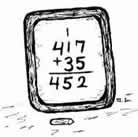
There were certain wrongdoings for which students got an automatic whipping, perhaps the worst punishment that could be administered. If a child stole or told a lie and was caught, he would get a whipping right in front of the whole class. This was the most embarassing punishment and students were almost cured from lying or stealing after a whipping. If they did lie or steal, they at least tried not to get caught. A teacher would often draw a circle on the board and make the student stand with his nose in the circle. The teacher might slap children's hands with a ruler. A punishment which might be thought to be typical of that time, writing a sentence so many times on the board, saying, "I'll never do that evil deed again," was never used. They just didn't have the chalk lying around to waste. Most of the discipline was physical and rather crude.
[28]
Discipline worked more on humiliation and embarassment. It was thought if you could embarrass a student enough he would never disobey again. Sometimes it didn't work that way. A youngster who could not stand to be humiliated usually didn't stick through the school year. He could simply leave school and get some kind of job, for in those days, there were many jobs available that didn't require an education. Jobs like cutting wood, splitting rails, and farm work only required a strong back and some common sense, not a formal education.
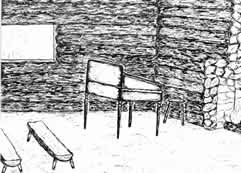
There is a story of a young man who at the age of twenty was still going to elementary school. He wasn't interested in learning. He went to school because he had nothing else to do. Why should he know about geography? He wasn't going anyplace. Why should he learn about reading and writing? There wasn't anyone who would want a letter from him and there wasn't anybody to write to him. But this young man, who raised and sold hogs, was told by one of his classmates that he was cheated when he sold some of his hogs. He got very upset that anyone would try to cheat him, much less succeed in the process, but the teacher and some of his classmates proved mathematically that he had indeed been cheated. This was enough to convince him that he should learn arithmetic. So it was agreed between the teacher and this unruly young man that he would behave himself in school and help to keep the school going. After that he was the one that disciplined the children on the school ground. When a couple of children got unruly in the absence of the teacher, he'd just simply discipline them to teach them their lesson. But one day in class, some pupils were beginning to misbehave. The teacher who was at her desk working heard a pop in the classroom. She looked up to see a boy lying flat on the floor. Later she saw her disciplinarian rubbing his knuckles, but when she asked the boy who had been lying on the floor what happened, he said, "Oh, I fell down. There isn't any rule against that, is there'?." He had done something wrong and had had to answer to the teacher's helper.
This same disciplinarian was involved in still another matter concerning a hickory nut tree. The school this young man attended was on property owned by a rather elderly man who had built a rail fence all around it. On the other side of the rail fence was a hickory tree and this old man was having problems with students climbing the fence and taking the nuts. He went to the school board, demanding they make a rule prohibiting the students from taking his hickory nuts. The school board said for this old man to write out a rule, and they in turn would present it to the teacher to read aloud to the students. So the old man wrote a rule saying, "Any kid climbing over my fence gets ten licks with the hickory switch." The children were all surprised. They wanted their hickory nuts, but they finally accepted the rule.
The original teacher's desk at the Delta School. It is one of the few remaining desks of that type.
The season went on but the hickory nuts disappeared just the same. The old man went to the school board, demanding they find the culprits who had been stealing the hickory nuts. Hearing about it, the teacher's helper told the teacher to read that rule the old man had written because nobody broke any rules. The teacher got the rule which said, "Any kid climbing my fence gets ten licks with the hickory switch." Then the young man said, "You follow me and I'll show you, ain't nobody broke any rules." The teacher and the students all formed a parade following the young man down to the rail fence. Working together the boys had lifted up a corner of the fence, putting a big rock under it so they could slide under to get the hickory nuts. So nobody "climbed" the fence, nobody broke the rules. That brought the old man to his senses because the joke was on him. The young man and his classmates didn't really want the hickory nuts--they just got a contrary streak.

But this same young man got to be a whiz in arithmetic. He came in the classroom one day and said, "Teacher, I learned something about arithmetic. You take any number you want to, add fourteen, and divide by two. Now subtract half the number you started with, add four, and your answer is eleven. The teacher's answer was eleven. She had to take that problem home that night and ponder over it. No matter what number she used in the beginning, her final answer was eleven. She was very impressed after that with this young man.
As this young man, students liked to use their own type of discipline on the teachers. They liked to embarass, humiliate, and astonish the teacher and put her in her place. This was a way to get back at the teacher and make the student feel a lot better for doing it.[30]In the early days, people didn't know the comforts we know today. Grooming was a whole different task back then and sometimes they ignored it for awhile. Hair was very difficult to take care of then, for they didn't have chemicals and shampoos, so in most homes women caught rain water in a barrel to wash their hair. They didn't try to curl their hair; it was much more practical to just wear it long and straight, although they often plaited their hair and braided it into pigtails. Boys wore their hair long because they had no barbers though not as long as they do now. They couldn't. If a boy let his hair get long and stringy, the other boys would just beat him up, because they thought he was a sissy.
The dress code was set by age. Little girls would wear what we now call midi skirts with a little flare. But the older they got, the longer the skirts got, too. By the time the girls were fifteen or sixteen, it was considered indecent to show their ankles. This idea probably came about because women were forced to accept long dresses to keep warm. The girls would have to wear a couple of petticoats under their dresses to keep from freezing.
There were no nylon stockings back then, only cotton and silk. Silk stockings were $2.65 a pair and when the man of the family was just making $4 or less a day he couldn't afford to buy many pairs of stockings for the women in the family.
People also didn't know of the comforts of having some time or some place just to relax. A school aged boy would be up before daylight feeding cattle, the horses, the pigs, and sawing and chopping wood. Then he'd carry the wood in his arms and stack a great pile of wood so that his mother wouldn't have to worry about fuel during the day. Then he would have to leave the house shortly after eight in order to make the mile and a half walk to school and get there by nine. He'd start school at nine and around ten-fifteen there would be a fifteen minute recess, after which classes would resume. At twelve o'clock there would be a noon recess during which the children would have their lunch break. After lunch they played essentially the same way we do now but without the fancy equipment. They played with a ball they had made out of old wool stockings that had been raveled out, rolled and stitched. They didn't know what a regular baseball was. They had no baseball gloves, no masks. Bats were usually whittled out of boards. After the last recess was over, they resumed with their last period of studies for the day. When school was out they headed for home again. If school was out at three-thirty, it would be close to four-thirty before they got home, which would be getting late in the afternoon on a winter day. Boys would be busy feeding the cattle, horses, and pigs and cutting the wood until after dark. Supper was eaten after the nightly chores, always after dark. Homework was usually the final duty of the day before going to bed.
A typical day for a girl would be essentially the same. When she got up in the morning, she'd help get the breakfast, which was no easy job like it is now. The flour all had to be sifted because it was lumpy. Then they had to make their bread and biscuits (which was a daily chore), fry the eggs, the sausage or pickled meat. She'd bring in the meat from the smoke-house and then wash the dishes. Dishwashing consisted of going out to the well and either drawing water in the bucket or pumping it in the hand pump and carrying in all the water that was to be used in the house that day. After the girl. and her' mother washed the dishes, she carried that dish water out to the hog trough so the hogs might get whatever sustenance there was in the dishwater. They tried not to waste anything. She would Follow the same routine after school, in preparing For supper.
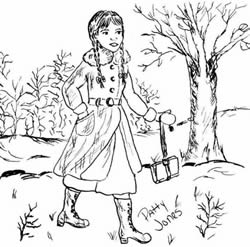
[31]
When these youngsters were not in school their day would consist of these same chores with additional ones to Fill in the time they had previously spent in school.
There was scarcely any social life among the youngsters. There were occasional play parties and box suppers, with community picnics in the summer. But the people who lived back then tell us that the work they did all day was Fun! We hunt animals now For Fun. They hunted -animals then so they could have fresh meat on the table, but they enjoyed hunting then as much as we do now,,
Perhaps one day we will get back to the old custom of hunting animals for Food because it is necessary, cutting our own timber, and doing all our own work. Maybe we will then get the feeling of enjoying our work, having Fun and satisfaction while doing it, so we wouldn't have to have places to go to and recreational diversions. Fun and recreation would take place in everyday living.

Copyright © 1981 BITTERSWEET, INC.
Next Article | Table of Contents | Other Issues
